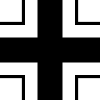Luftwaffe
| Luftwaffe | |
|---|---|

Emblem of the Luftwaffe (variant)
|
|
| Active | 1933–46 |
| Country |
|
| Type | Air force |
| Size |
Aircraft 119,871 (total production) Personnel 3,400,000 (total in service at any time for 1939–45) |
| Part of | Wehrmacht |
| Engagements |
Spanish Civil War World War II |
| Commanders | |
| Notable commanders |
Hermann Göring (1933–45) Robert Ritter von Greim (1945) |
| Insignia | |
| Balkenkreuz (fuselage and wing undersurfaces) |  |
| Balkenkreuz (upper wing surfaces) |  |
| Fin flash - Hakenkreuz (swastika)(1939-1945, white border omitted late-war) |  |
The Luftwaffe (German pronunciation: [ˈlʊftvafə]) was the aerial warfare branch of the combined German Wehrmacht military forces during World War II. Germany's military air arms during the First World War, the Luftstreitkräfte of the Army and the Marine-Fliegerabteilung of the Navy, had been disbanded in May 1920 as a result of the terms of the Treaty of Versailles which stated that Germany was forbidden to have any air force.
During the interwar period, German pilots were trained secretly in violation of the treaty at Lipetsk Air Base. With the rise of the Nazi Party and the repudiation of the Versailles Treaty, the Luftwaffe was officially established on 26 February 1935. The Condor Legion, a Luftwaffe detachment sent to aid Franco's Nationalist forces in the Spanish Civil War, provided the force with a valuable testing ground for new doctrines and aircraft. Partially as a result of this combat experience, the Luftwaffe had become one of the most sophisticated, technologically advanced, and battle-experienced air forces in the world when the Second World War broke out in 1939. By the summer of 1939, the Luftwaffe had twenty-eight Geschwaders (wings).
German day and night fighter pilots claimed roughly 70,000 aerial victories during World War II, 25,000 over British or American planes and 45,000 over Russian-flown aircraft. 103 German fighter pilots shot down more than 100 enemy aircraft for a total of roughly 15,400 aerial victories. Roughly a further 360 pilots claimed between 40 and 100 aerial victories, destroying approximately 21,000 enemy planes. Another 500 fighter pilots claimed between 20 and 40 victories for a total of 15,000 victories. It is relatively certain that 2,500 German fighter pilots attained ace status, having achieved at least 5 aerial victories. 453 German day and Zerstörer (destroyer) pilots were honored with the Knight's Cross of the Iron Cross; 85 night fighter pilots, including 14 crew members, also won the award. But as dramatic as the Luftwaffe's victories may have been, the force did suffer extremely heavy losses. Over the course of the war, an estimated 76,875 Luftwaffe aircraft were destroyed or significantly damaged; of these, nearly 40,000 were lost entirely. (By type, losses totaled 21,452 fighters, 12,037 bombers, 15,428 trainers, 10,221 twin-engine fighters, 5,548 ground attack, 6,733 reconnaissance, and 6,141 transports.)
...
Wikipedia
